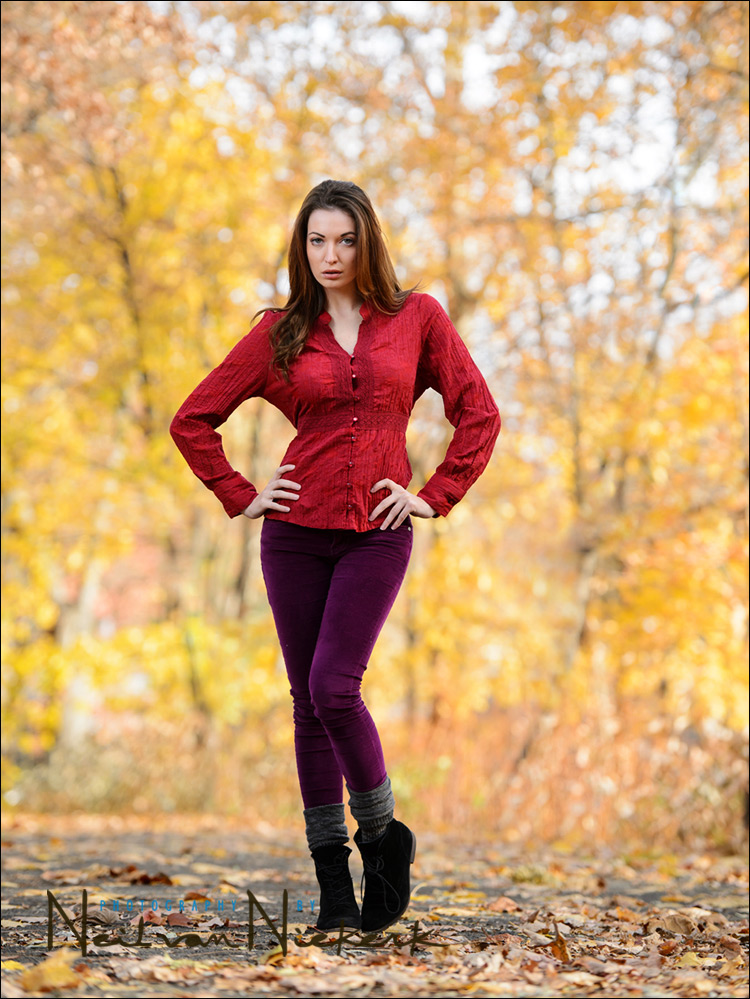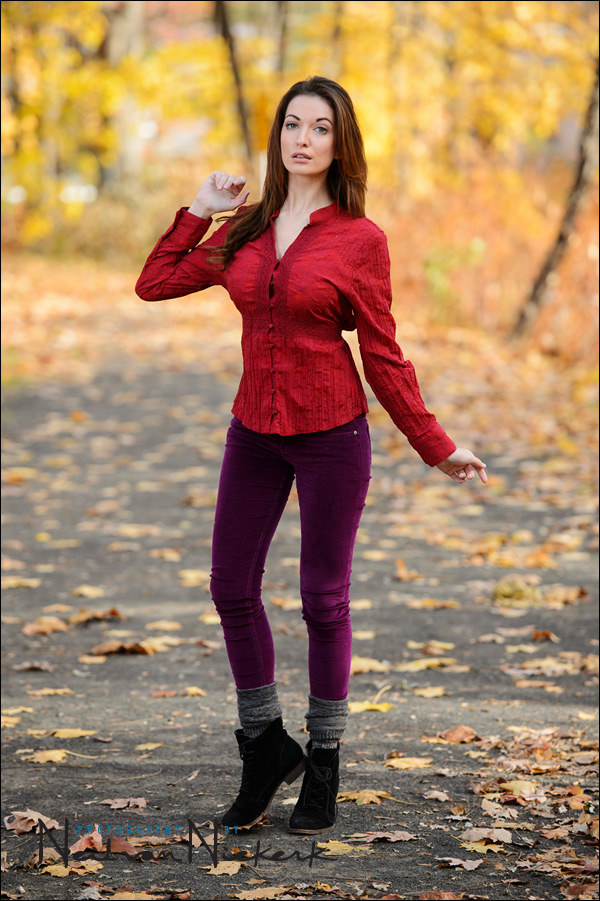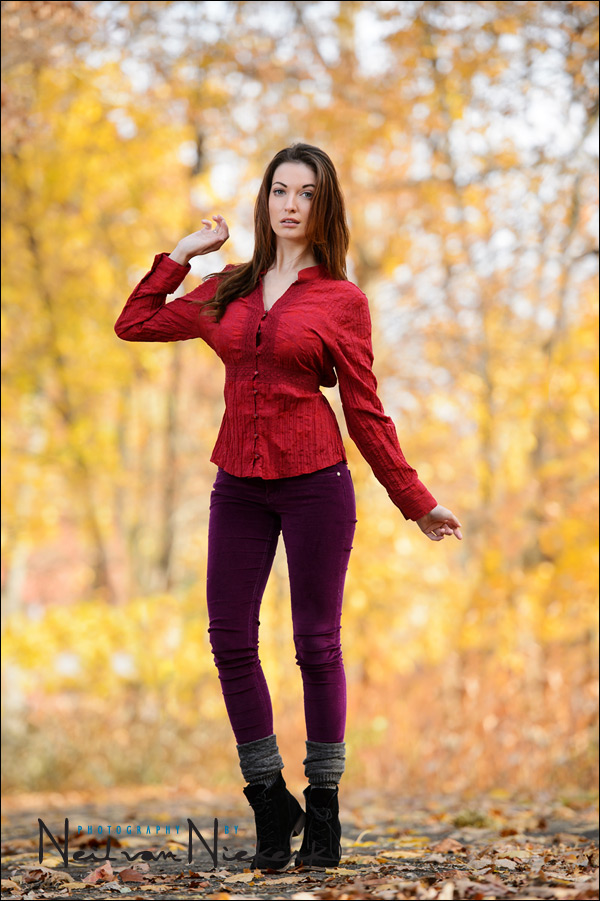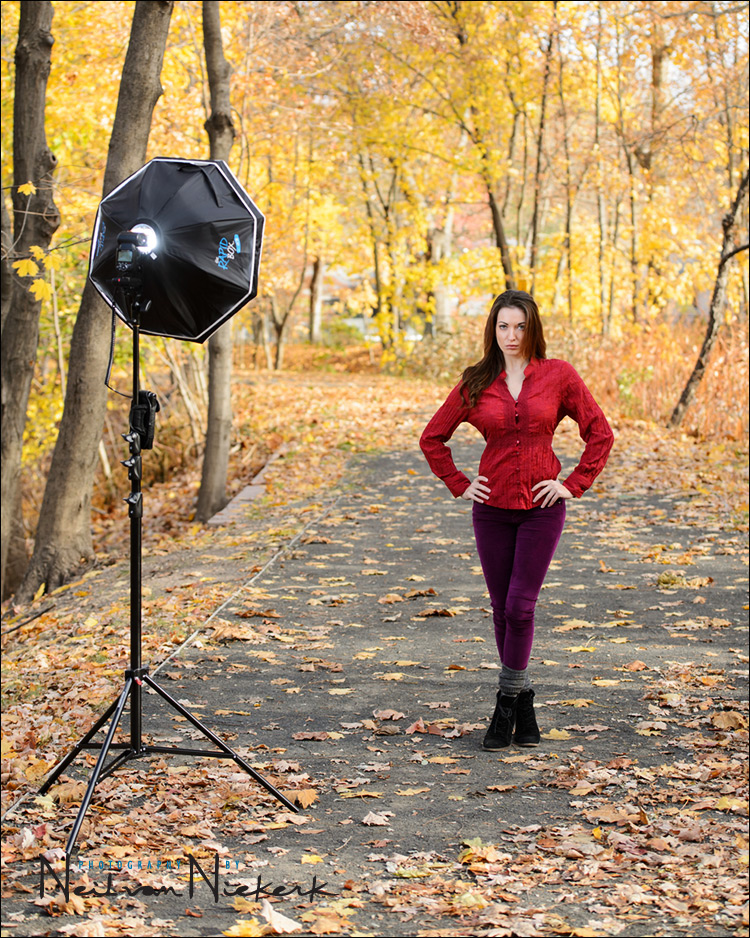
Photography composition – Getting down lower for a better perspective
It’s a bit of a cliche perhaps, seeing a photographer on the ground, laying on his side, or sprawled on the ground. What might look like a strange form of attention-seeking, is actually a very solid way of improving your composition with full-length portraits. The lazy temptation is to just stand there, camera to the eye, and take the photograph. What happens then (usually), is that the photographer is shooting down on the subject. The best advice generally, is to step back for full-length compositions. When you shoot down on someone, especially with a wider angle lens, is that the perspective distortion cause the feet to appear much smaller, and your subject’s head to be disproportionally larger.
With a longer focal length, such as used in this outdoors portrait of Elle, perspective distortion is less of a concern. The lens was zoomed to around 135mm, and that means her head and feet are equidistant to the camera. No distortion. (By the way, this was taken during a photography workshop at my studio.)
However, if you, as the photographer, take the photo just standing at full height, then you are still shooting down, and you’re getting far too much of the ground in the image. The path here behind Elle isn’t awful, and doesn’t distract. But it’s the colors behind her which helps make this image pop, complementing the colors of her clothing.
So let’s look at a series of three images, shot while I was standing up, kneeling down, and finally, laying flat on the ground. Notice how the background changes as my perspective changes.



By eliminating much of the ground, this straight-forward portrait of Elle has more impact. This is something I always check for when photographing someone – whether I can tighten the composition by shooting from a lower angle. Even a slightly lower angle would’ve eliminated most of the pathway here.
And as always, a pull-back shot to show the lighting setup. Just a touch of fill-flash to give flattering light on her. Notice that shadow on the ground there at her feet? I specifically posed her there so that there would be no dappled light on her. It’s very much part of lighting technique for on-location photo sessions – pick your battles!

camera settings: 1/250 @ f/3.5 @ 200 ISO … manual flash.
Photo gear (or equivalents) used in this photo session
- Nikon D4
- Nikon 70-200mm f2.8 AF-S VR II / Canon EF 70-200mm f/2.8L IS II
- Westcott Rapidbox – 26″ Octa Softbox
- Manfrotto 1004BAC – taller, heavier light-stand
- Nikon SB-910 Speedlight / Canon 600EX-RT Speedlite
- Nikon SD-9 battery pack / Canon CP-E4 battery pack




A great piece of advice, Neil, thank you! For many of us, beginner(ish) photographers, it is very easy to forget about these things when we’re thinking about ISO, shutter speed, aperture, flash power, focal distance, the direction of light, communicating with the model etc. And it is amazing how such a relatively small change in photographer’s position can have such a great impact on the final image. This is also discussed in the Fstoppers’ tutorial on wedding photography – generally, don’t shoot a couple who are sitting on the ground from above, or you will end up with grass and ground all around them, and there’ll be no (or little) separation. It is much better to get really down, so you can have trees etc. in the background, all nicely blurred.
It would be interesting to see how you, Neil, communicate with couples during shoots, how you make them relax, etc. Do you tell jokes? Or are you mostly quiet and let them do whatever they feel like?
This is something that would be easier to see with video clips … so that’s something I intend posting more of in future.
Neil, nice post about changing perspective. Question about the Rapid box; do you use the internal deflector regularly or ever? I’m very close to picking one up to augment my collection of location stuff which is the white interior 24×24 Lastolite and a 15×15 Quickbox. I’m wondering about the deflector though. I’ve used a similar piece from Elinchrom with higher powered lights where I noticed the drop in output. I’m not sure I want that with a SB-910. Thanks.
I used the deflector plate here … but I’m not that fond of it, because it takes a minute to add … and you can’t fold the softbox down with it still in place. So if you’re going to carry this thing around while still mounted on a light-stand, then it is easier to do so without the deflector plate. And yes, it does kill some of the light.
Excelent topic!! Thanks Neil.
I love following all of your post, and this one was nicely done as usual. When you use speedlites, would it be possible to start posting the settings on the lights, as you do with the settings on the camera?
It wouldn’t make sense here, since the softbox that is used, will alter the output. So just saying that the flash was at 1/4 power is essentially meaningless. Also, it isn’t something I usually take note of.
And ultimately, the thought-process is much more insightful than the actual numerical value.
Thanks for another great post, Neil! I understand the distortion issue pointed out in the post, but I’ve always been told photographing from a higher perspective makes a person’s face look thinner. My understanding is that a top-down perspective of a face is more flattering than a bottom-up perspective, which might draw attention to a double chin, for example. What piece of the puzzle am I missing?
Thanks,
Justin
I had her lean a tiny bit forward to me, and push her chin a tiny, tiny bit out to me. So I do keep in mind that I need to adjust for the position that I am shooting from.
More than that though, I don’t want to get stuck in a mode of Only One Correct Way Of Doing Something. If the image works, it works.
Excellent advice Neil. Great background
As usual, very refreshing and educational. Thank you!
Just for kicks I was trying to zoom into my browser to see if i could read your flash power settings …. I couldn’t. My guess is about 1/8th power – how right am I ? :)
I shot with the PocketWizard TT5 flash triggers, so my flash would’ve been set to TTL to allow the master trigger to control it. It would be set to TTL whether I am using the flash in Manual mode, or TTL mode purely because this is how the TT5 and TT1 units work.
As I mentioned earlier, the absolute value for the flash’s output would be meaningless here.
Neil, thank you so much for posting this, as the subject you’ve discussed has actually been on my mind for days!
Beautiful image as usual. One thing that I notice is the position of the hands and fingers in the initial image. Can you give us some advice on how to position the hands please? Much appreciated.
The two most important things to look for, is that you don’t see the “blocky” back of the person’s hand, or the “blocky” full front of the palm. You want an elegant curve to the fingers and wrist.
I find the kneeling(second of the three) photo to be the best, with the lens closer to the height of her midpoint her proportions seem the most balanced. It’s hard to say that would hold true in other trials.
Great article though, composition doesn’t get enough attention.
I was shooting really low all this while without realizing why I was doing this! I just knew the results were good. Its good to know why!
Thanks!
Great tip Neil. I find the desirability of shooting low is inversely proportional to the age and/or weight of the subject(s). Clients hate the dreaded double-chin.
I really love your website and your picture breakdowns explaining how the shot was created. Have you ever thought about going on CreativeLive and making a webinar?
Truely great photos, your a real artist and a great teacher.
Thanks for being so generous
Bring back waist level finders!
Neil, apart from the times you use TTL or ETTL flash, do you meter the flash to ambient ratio when shooting outdoors on shoots such as this? If yes, is there a favourite range of ratio?
One other question – using the softbox and the speedlight, as in the pull back shot above, how far can your flash be from the subject (in the softbox) before it stops having any worthy effect on the image, and typically whats your preferred distance ?
I totally agree, I got lazy after 2 knee operations and the background cutting the subjects in half drove me back to the gym, to strengthen the muscles around the knees again.